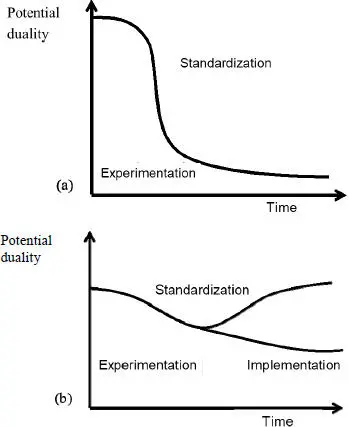Francois-Xavier Meunier - Dual Innovation Systems
Здесь есть возможность читать онлайн «Francois-Xavier Meunier - Dual Innovation Systems» — ознакомительный отрывок электронной книги совершенно бесплатно, а после прочтения отрывка купить полную версию. В некоторых случаях можно слушать аудио, скачать через торрент в формате fb2 и присутствует краткое содержание. Жанр: unrecognised, на английском языке. Описание произведения, (предисловие) а так же отзывы посетителей доступны на портале библиотеки ЛибКат.
- Название:Dual Innovation Systems
- Автор:
- Жанр:
- Год:неизвестен
- ISBN:нет данных
- Рейтинг книги:4 / 5. Голосов: 1
-
Избранное:Добавить в избранное
- Отзывы:
-
Ваша оценка:
- 80
- 1
- 2
- 3
- 4
- 5
Dual Innovation Systems: краткое содержание, описание и аннотация
Предлагаем к чтению аннотацию, описание, краткое содержание или предисловие (зависит от того, что написал сам автор книги «Dual Innovation Systems»). Если вы не нашли необходимую информацию о книге — напишите в комментариях, мы постараемся отыскать её.
Dual Innovation Systems — читать онлайн ознакомительный отрывок
Ниже представлен текст книги, разбитый по страницам. Система сохранения места последней прочитанной страницы, позволяет с удобством читать онлайн бесплатно книгу «Dual Innovation Systems», без необходимости каждый раз заново искать на чём Вы остановились. Поставьте закладку, и сможете в любой момент перейти на страницу, на которой закончили чтение.
Интервал:
Закладка:
During the standardization phase, the application domains require specific adaptation to the defense case or to the civilian case (norms, regulations, etc.). Each application caries on developments that lead to technological trajectories diverging between the two domains, and reduce the number of potential collaborations.
Then, things depend on the type of project: once more, according to Cowan and Foray, the potential of a product-oriented project is not the same and does not evolve at the same pace as the potential of a process-oriented project. A product-oriented project has a lower dual potential, as it is limited by demands specific to the application domain. Moreover, the standardization phase strongly reduces this potential even further. A process-oriented project is, on the other hand, less limited by the civilian or military specificities and the standardization phase can be at least in part jointly conducted, leading to civilian and military convergence on the implementation of the technology.
In this approach, duality is perceived as a mechanism for the joint production of technology. Organizing R&D according to duality principles would then enable a larger number of potential applications, the delay of standardization-related technology lock-in and consequent preservation of technology variety.
On the other hand, other research according to the technology lifecycle has proved that defense may show renewed interest in technologies after their standardization in the civilian sector, and thus revive their dual potential (Sachwald 1999). Duality is perceived here as a spin-in getting close to the off-the-shelf purchase practice within a cost reduction policy.
A last note on temporality is worth making in relation to the life time of a defense program, and particularly to its maintenance in operational conditions (MOC). This characteristic of defense programs increases the complexity of the civilian–defense relation. Indeed, even if, as underlined by Droff (2013), in MOC duality facilitates the proximity between civilian and military activities, the fact remains that, due to regulatory and operational constraints of military MOC, manufacturers have to maintain competences and technologies for a very long time after their development. In these types of activities, duality is related to transfers or to the provision of equipment adequate for a given territory.

Figure 1.1. Technology cycle and dual potential. (a) Product-oriented; (b) process-oriented (source: Cowan and Foray 1995, p. 858)
Given these considerations on the temporal dimension, a priori knowledge on the applications of a technology in the future seems unlikely, as the majority of them have multiple uses (Sachwald 1999). In addition to temporality, some consider that future applications of a technology depend in particular on the social network in which it is developed or used (Cowan and Foray 1995; Kulve and Smit 2003). In innovation sociology, the notion of collaboration between network actors is essential for the economic dynamics. The concepts of techno-economic networks (Callon 1991) or sociotechnical networks (STN) (Elzen et al. 1996) point out this aspect; they are also the source of inspiration for the approaches of duality that place the collaborations between actors at the core of the analysis (Kulve and Smit 2003). Their main contribution is that the study of duality is no longer focused on technologies, but on the networks in which they emerge. The characteristics of these networks are susceptible to facilitating dual development. The idea of a temporality in the dual potential, as advanced by Cowan and Foray, is preserved, together with the idea of transfer mechanisms specific to each situation.
This approach inspires the most recent works on duality and the innovation system perspective is nowadays often preferred for the integration of these network effects in the analysis (Guichard 2004a; Guichard and Heisbourg 2004; Mérindol 2004; Serfati 2008; Bellais 2014). The system set-up, animation and organization are presented in this context as essential challenges of dual technological innovation.
The approaches in terms of innovation system do not fit the “outdated perspective of technical change that is taking place quasi-autonomously from the rest of economy” (Amable 2003). In defense economics, it is the multidimensional nature of this approach that renders it particularly interesting for addressing matters of organization, governance or strategy of duality.
1.3. Actors and objectives of duality
Duality organization refers directly to expected (economic, technological, strategic) performance, which varies depending on the actor and influences their behavior (Lu et al. 2015). Its implementation associates sometimes conflicting challenges, from knowledge management to public policy challenges (Daguzan 2001). Moreover, there are different ways to consider duality, and therefore various objectives and different strategies. Similar to the definition of a dual object, there is no general agreement on the principles that should guide duality implementation.
For a proper consideration of this diversity in the implementation of duality, this section studies the matter from the most microeconomic perspective (company strategy) to the macroeconomic level (international relations).
1.3.1. Dual strategies of companies
At the end of the Cold War, given the decrease in defense expenditure, the production of systems for military purposes was gradually privatized and consolidated around large groups. These companies can then consider duality as a means to reach a balance and stabilize results in a contracting or at least very cyclical market (Depeyre 2013).
From then on, from a company perspective, dual strategy involves addressing both civilian and military markets. Duality is intuitively represented as a means to achieve economies of scale or scope. This however requires many adjustments within such a company, which must reconcile more or less diverging regulatory, technical, financial and commercial constraints. The analysis proposed by Mérindol and Versailles for Thales company is particularly instructive. In this article, Thales strategy is referred to as “global duality”. “The company is trying to benefit from its technological advantage by developing synergies between the solutions proposed for a set of products on adjacent markets (defense, aeronautics, land transport, etc.)” (Mérindol and Versailles 2015b, p. 10). The analysis indicates the influence that such a strategy has on the competences and technological developments of a company.
In reality, there are various ways to consider a dual strategy. One case may involve market diversification without diversification of competences; this amounts to capitalizing on its competences by adapting its offer to new clients. A reverse approach to dual strategy may involve proposing new products to the same (military or civilian) clients using new competences coming from the other sector, in completion to those already existing in the company. Duality is then the result of strategic reflection for the company whose objective is, in one case, to shift specific resources to a new market (market diversification), while in the other case the objective is to take advantage of new resources for the same market (product diversification). Less often, it involves both simultaneously.
Whatever the situation, this dual diversification requires reaching a compromise between two sometimes distant universes. Literature stresses three challenges that the companies should address; they refer to the role of demand, financing needs, and management of competences.
Читать дальшеИнтервал:
Закладка:
Похожие книги на «Dual Innovation Systems»
Представляем Вашему вниманию похожие книги на «Dual Innovation Systems» списком для выбора. Мы отобрали схожую по названию и смыслу литературу в надежде предоставить читателям больше вариантов отыскать новые, интересные, ещё непрочитанные произведения.
Обсуждение, отзывы о книге «Dual Innovation Systems» и просто собственные мнения читателей. Оставьте ваши комментарии, напишите, что Вы думаете о произведении, его смысле или главных героях. Укажите что конкретно понравилось, а что нет, и почему Вы так считаете.











